| Day Seven (Sat): | Shinjuku - Shibuya - Aoyama - Meiji Jingu - Harajuku - Shinjuku |
| Breakfast: | Burger with a Japanese Twist - Part II Mos Burger, Shibuya |
| Lunch: | Kyoto-style 8 course kaiseki lunch at a fair price Minase, Minami Aoyama |
| Dinner: | Tempura at a 100-plus-year-old Specialist Funebashiya, Shinjuku |
Second last day of our Greater Kanto tour. After spending so many days hunting for photos ops and good food, it's time to do some serious shopping. That's not to say we're gonna stop hunting for good food though!
Burger with a Japanese Twist - Part II
Yesterday's Ebi Burger at Lotteria convinced us to seriously try a proper Japanese burger. So we headed for a burger chain noted for its innovation and taste, famous among both the locals and the Gaijin. You guessed right -- the widely loved MOS Burger.
Check out its menu here...hmm...so many choices. We ended up with the simplest and most representative burger at MOS Burger, the original MOS Burger itself with its signature meat sauce and onion. It was fully deserving of its reputation as a very Japanese burger, not because of the ingredients (which is typically American), but because of the soft, almost melting texture of the patty. It was like Wagyu in a burger bun.
Shibuya
I'm not going to talk too much about Shibuya since I need more space for the food descriptions below; you can read more about this trendy one-stop shopping district here, here and here if you wish. We ended up buying the newest Nikon digital camera at Sakuraya, and then headed to Minami Aoyama looking for the biggest and one of the most anticipated lunches of our trip.
Gourmet Spot #13: Kyoto-style 9 Course Kaiseki - Minase, Minami Aoyama
What's so special about Kaiseki? Short answer: it's simply the undisputed pinnacle of Japanese culinary craft. Better answer: it's a highly sophisticated culinary art form, where the chef prepares a whole plethora of the best seasonal ingredients presented in their best natural flavors, and presents the bounty of nature to the client dish-by-dish with a succession of visual exhibitions arranged with painstaking details. It is truly meant to be an epicurean pleasure for the palate and the eye. As one serious fan of Japanese food to another, I can tell you that it's worth it to try it at least once in a lifetime.
And it doesn't have to be a 30000 yen meal for two. Many Kaiseki restaurants also serve slightly less extravagant lunch sets at incredible discounts, partly as an effective advertisement for the dinner session.
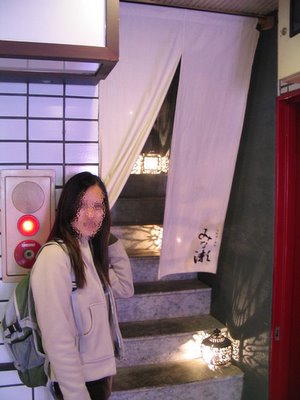
This dim, lantern-lit staircase led to Minase, a Kyoto-style Kaiseki restaurant inconspicuously concealed inside a low building in a narrow residential alley. We had so much trouble finding this place even with the help of this printout map. After 30 minutes of circling around the blocks we were even ready to give up, but luckily it appeared right when we took our final circle.
Seated in front of a gorgeous top-to-bottom glass window facing a traditional Kyoto courtyard of green bamboo and red Japanese maple, we ordered one Mini Kaiseki course (Mini is a relative word, as you will see) and one Shokado Bento (which practically was a whole Kaiseki course compacted into one box). The staff were very courteous, even trying their best to speak in English. I think they were scared of my Japanese.
I'll start with the Mini Kaiseki course. Note the emphasis on the seasonality in the ingredients and presentation.
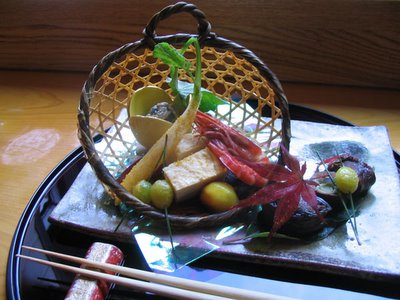
The first dish, the Hassun (literally "8 inches", referring to the length of the side of the square dish). So beautifully arranged you can see the Autumn within the ingredients.

The second dish, the Suimono (sipped dish) which is a clear soup with a delicious Dashi base and the freshest of vegetables.

The third dish, the Mukouzuke (literally "located beyond", refering to this item being served beyond the first two dishes). The sashimi items, especially the Maguro, were all very fresh, though not to the level of Tsukiji Sushi Dai (see Day 3).

The fourth dish, the Takiawase (a combination of cooked items). Another enjoyable dish, especially the white Satoimo at the bottom.

The fifth dish, the Yakizakana (grilled fish). I'm not sure what it was (Sawara perhaps?), but it certainly was beautifully broiled.
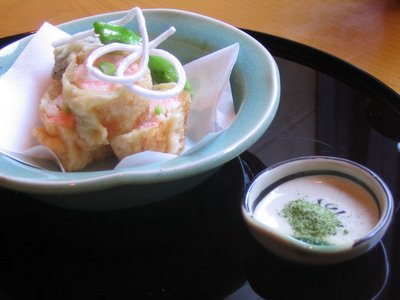
The sixth dish, the Aburamono (oil fried dish). Great skill was evident in the preparation of this minced shrimp roll, as the batter did not taste oily at all. The green pepper was also very fresh and very well fried. Also note the high quality Matcha salt used for dipping.

The seventh dish, the Oshokoji (literally a meal, meaning the most filling part of a meal). It was an Oyako (mother and son) Zozui with salmon and roe. At this point, it was already too filling for us.
The eighth dish was a Kounomono (pickled vegetables), which was not photographed.

The ninth dish was a non-traditional Okashi (dessert), a fusion of western ice-cream and fruits laid upon a base of creamy traditional red bean paste. Strange ending to a traditional meal, but enjoyable nevertheless.
And now, the Shokado Bento. Don't let the word Bento (lunch box) fool you into underestimating this meal. It was a 10-course Kaiseki served in a box...
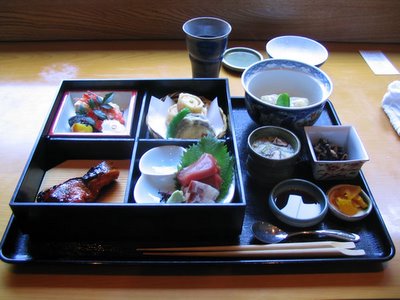
Like this! Eight of the ten courses are presented here. Where in the Bento are we supposed start? From the top left corner, going column-by-column top to bottom, then left to right.

The first dish was again the Hassun, also served in a square dish (though not 8 inches per side). Excellently fresh (and huge!) shrimp was the centerpiece.
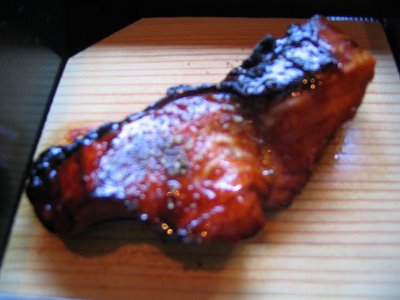
The second dish, the Yakimono (broiled dish). It was the same high quality broiled fish as in the Yakizakana dish of the Mini Kaiseki above.

The third dish, the Agemono (deep fried dish) was a slightly smaller version of the Aburamono dish of the Mini Kaiseki, with the same incredible minced shrimp roll. Did I mention the skill of this chef?

The fourth dish, the Otsukuri (sliced raw items). A medley of fresh Maguro and Tai. I think I broke the order and finished this dish before everything else! Anyway, saving the delicate flavors of raw fish for right after a deep fried dish didn't seem a good idea to me at the time. But then I was probably wrong...what do I know about Kaiseki?

The fifth dish, the Kobachi (small bowl). I think it was Konnyaku inside a paper thin wrapping of Tofu and presented in a Dashi broth.

The sixth dish was the small dish of Takiawase at the right. I wasn't sure what it was actually.
The seventh dish was the Mushimono (steamed item) at the left of the picture. A steamed custard of various goodies including Shiitake and Enoki mushrooms.
The eighth dish was the Oshokuji, which was a bowl of high quality plain rice. I was so busy helping my wife finishing the Mini Kaiseki that I barely touched it.
The ninth dish was the Kounomono (pickled vegetables).
And finally the tenth dish, the Suimono (sipped dish). Whew. A clear broth to aid digestion surely came at the right time!
We also learned something interesting during the meal: A small family consisting of three generations arrived at the restaurant, all dressed up in formal gown (grandmother, mother and a little girl in formal Kimono, the father and a little boy in suits). I admired the cutely dressed children without giving it very much thought.
The manager, standing beside our table, watched the family from a distance and said something in admiration. The only word I caught was "Matsuri" (festival) and so I curiously inquired. Matsuri? Hai! Then he told us why this would be the perfect day to visit our pre-planned destination for this afternoon -- the Meiji Jingu.
| Bill for two persons: | |
| Mini Kaiseki | 3990 yen |
| Shokado | 1890 yen |
| (apply 10% service charge) | |
| Total | 6468 yen |
Meiji Jingu during the Shichi-Go-San Matsuri
We were filled up to the throat as we left Minase, needing a long afternoon walk. And what better place for a leisurely stroll on a sunny Saturday afternoon than the majestic Meiji Jingu's courtyard, lined with the Autumn foliage of red Japanese maple and bustling with little children in their Shichi-Go-San festive Kimono?
Here is some info about Meiji Jingu, where the late Emperor Meiji (of Restoration fame) is enshrined. The huge Yoyogi Park surrounding the shrine makes for a peaceful urban oasis -- once you get past those budding Visual Rock bands performing on the sidewalk near the park entrance every weekend.

Kawaii deshou ne? The entire courtyard was full with cute little children all dressed up for the Shichi-Go-San Matsuri, a rite of passage festival for girls of 3 and 7 and boys of 3 and 5. Girls and their mothers were dressed in formal Kimono, while the boys and their dads were typically dressed in Kimono or western suits. This family here has kids of all three ages.
Harajuku Fashion
Right outside of the serene Yoyogi park is the epicentre of Japanese youth fashion trends -- the teen hangout of Harajuku. With a whole maze of little alleys full of little independent fashion shops selling a huge array of different fashion items and cute household goods. Some of the newer items were sold at exorbitant prices, but mostly the prices were very reasonable, especially at the Chuuko (2nd hand) clothing outlets.
This was to be the most expensive day of our trip. Along with the camera we bought this morning, we probably spent 60000 yen on various goods -- not a big amount for shopping in Tokyo (after all we didn't buy anything at Ginza), but still a major chunk of our budget. But comparing with the prices at home, all that we bought were definitely at a discount.
It was a long day of shopping and the weariness of travel had forced my wife to retire to watching some Japanese TV at the hotel room. Luckily that lunch was huge. At 9:00PM, way past my normal supper time, I had to venture out once again, to pay a visit to the final century-old-restaurant of this trip.
Gourmet Spot #14: 100-Year-Old Tempura Specialist - Funebashiya Honten, Shinjuku
Just one block from the busiest streets of the busiest neighborhood, this old tempura house near JR Shinjuku station's East Exit looked like a modest little eatery from the outside. It was not among the classiest restaurants, but when a little street-corner Tempura-ya could outlive the entire 20th century and spawn a few sister restaurants across Tokyo,there has to be something special about its tempura.

Lasuto Oda...the waiter reminded me at I sat down. Last order at 9:30PM? That sounded atypical of Shinjuku restaurants, but on the bright side, I still had half and hour to indulge in the freshest deep-fried seafood, and the entertainment of the chef preparing and frying them before my eyes.
Last order meant I had to order everything at once, and so I started with the plainly-named Tempura Teishoku B, consisting of 2 Maki Ebi (large shirmps), 2 types of fish, Ika (squid), 2 types of vegetables, finishing with a Kakiage (tempura patty). I added one more item from the a la carte menu: the shrimp head tempura.

The meal setting was typical of tempura restaurants, with pickles, grated radish, a dipping bowl for Tempura Tare, Miso soup and rice. I ended up not even using the Tempura Tare much, not because I didn't like the sauce, but because the Matcha salt tasted so good. To me, that is the first sign of an good Tempura house.

Coming up first was the two Maki Ebi and the Ika. You can see the skill of the tempura chef from the size of the oil stain on the oil-absorbing paper -- this one was pretty good. The tempura looked only slightly oily, and actually tasted not oily at all. And the Matcha salt was the perfect match for this light and crunchy shrimp tempura. It was so good I didn't even waste the tail shell.

Then came the fish. The piece at the top left with the black tail was a Kisu, a very fresh and sweet fish. And there was a piece of Megochi just behind it.
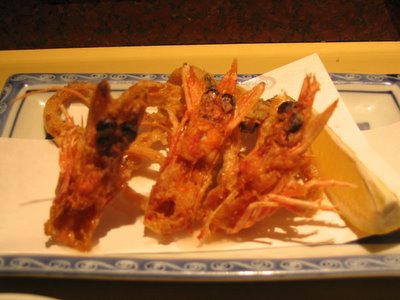
Shrimp heads. Good source of calcium and euphoria. Some people might find it strange to consume these normally discarded parts, but these were so crunchy and delicious they were like shrimp crackers, only even better with a much stronger shrimp taste.

Veggies for a balanced diet. The eggplant was very tasty.

At this point I was getting very full, and so I do not remember the taste of this Kakiage. It probably wasn't as excellent as the gigantic one I had at Odawara on Day 5 though, but less oily.
I finished the meal at way past closing time and was one of the last customers out of the restaurant. The chef who served me didn't seem to mind me delaying him closing shop though. Gochisosama Deshita!
| Bill for One Person: | |
| Tempura Teishoku B | 2600 yen |
| Shrimp Heads | ~400 yen |
| (apply 5% tax) | |
| Total | ~3150 yen |
Không có nhận xét nào:
Đăng nhận xét